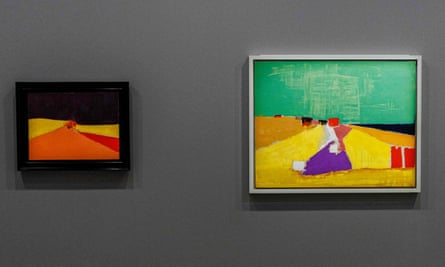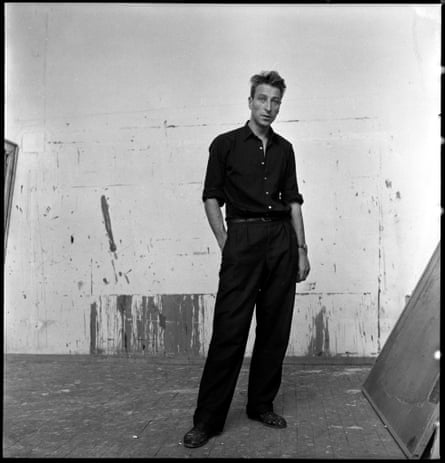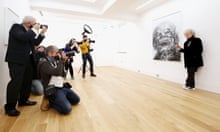The life of the Russian-born French artist Nicolas de Staël was short, turbulent and ultimately tragic.
Forced into exile by the 1917 revolution, orphaned, a loner who was hopelessly romantic but unlucky in love, De Staël died at the age of 41 after he threw himself out of the window of his Côte d’Azur atelier after the woman with whom he was obsessed rejected him.
It is his end that, in part, has created a “De Staël myth”, which art experts lament has often overshadowed the more than 1,100 oil paintings, and a similar number of drawings, he produced in a frenetic 15-year career. The influential French magazine Beaux Arts described De Staël as “one of the 20th century’s most mysterious painters”.
A new exhibition opening at the Museum of Modern Art in Paris on Friday, aims to put the art back at the centre of the De Staël story, with a collection of 200 paintings, drawings, engravings and notebooks. Many of the works on display are in private collections and have never been seen in public before.

Charlotte Barat-Mabille, one of the curators, said she believed it was “one of the most beautiful exhibitions we have ever had at the Museum of Modern Art”, and she and colleagues had combed private collections to handpick works to display in a chronological order, unlike the thematic approach of a retrospective at the Pompidou Centre 20 years ago.
“Nicolas de Staël was fascinated by the world around him and produced much work in a short time. His career was brief but prolific,” she said. “But the myth has had a habit of overshadowing his work. For De Staël the only thing that counted was to paint and to seek to show something new in the paintings.”
De Staël was born Nicolaï Vladimirovitch Staël von Holstein into a high-ranking military family in the tsar’s court in St Petersburg –then called Petrograd – forced into exile during the 1917 revolution when he was just three years old. His parents died shortly afterwards and De Staël and his two sisters were sent to be raised by a Russian couple in Belgium.

After studying art in Brussels, De Staël travelled around the south of France, Spain and Morocco where he met his partner, Jeannine, a married artist with a young son who he persuaded to run away with him. After enlisting with the Foreign Legion in 1939 he was demobilised less than a year later and returned to Nice, then Paris. The couple lived in extreme poverty, burning furniture to keep warm in winter, as De Staël struggled to make a living. During this period, the couple lived on the paintings Jeannine sold, but in 1946, she died weak and malnourished after terminating a pregnancy that had threatened her life.

Within three months, the widowed De Staël had met and married his second wife, Françoise Chapouton, and moved his family to the south of France, but less than five years and three children later he was madly in love again, with Jeanne Polge, a married mother-of-two.
By now enjoying success exhibiting and selling paintings, De Staël packed his wife and family back to Paris and settled in an apartment in Antibes to be near Jeanne. When she refused to leave her husband or see him, Staël furiously completed his last work, a massive 3.5 metre by 6 metre canvas called Le Concert (Le Grand Concert: L’Orchestre), in three days, then ended his life.
“The myth of his troubled personality and tragic end has been to the detriment of De Staël’s work. It has prevented people seeing the beauty of his oeuvre and viewing it as a celebration of existence,” Fabrice Hergott, director of the Museum of Modern Art in Paris said at a preview this week.
“The aim of this exhibition is to show what a great, original and atypical painter De Staël was.”
In a brief visit to Paris shortly before his death, De Staël told a friend: “I am lost … perhaps I have painted enough.”
Gustave de Staël, the youngest of the artist’s four children born a year before his death, said the suicide was “a spur of the moment act” and that his mother always said if there had been someone with him at the time he would not have ended his life.
“If you look at his last works they are full of life. I don’t see sadness or melancholy in them.
“He had spent the summer and winter alone at his atelier in Antibes, he was exhausted and I think he’d had enough of this solitary tête-à-tête he’d been having with himself. In the end he had no hobbies or other interests; he was always working and he sought solitude so he could give the maximum of himself to his paintings.
“Maybe he felt he had wrung himself out as far as painting was concerned and had nothing more to give. I believe he could have continued to show us so much more especially in his use of colour, but it was not to be.”
This article was amended on 18 September 2023. Nicolas De Staël produced 1,100 oil paintings and a similar number of drawings during his career, not “1,100 oil paintings and drawings” as an earlier version said. Jeannine was his partner rather than his “first wife”. And he had four children rather than five.
Nicolas de Staël: Museum d’Art Moderne de Paris, 15 September 2023 to 21 January 2024
In the UK and Ireland, Samaritans can be contacted on freephone 116 123, or email jo@samaritans.org or jo@samaritans.ie. In the US, you can call or text the National Suicide Prevention Lifeline on 988, chat on 988lifeline.org, or text HOME to 741741 to connect with a crisis counselor. In Australia, the crisis support service Lifeline is 13 11 14. Other international helplines can be found at befrienders.org









